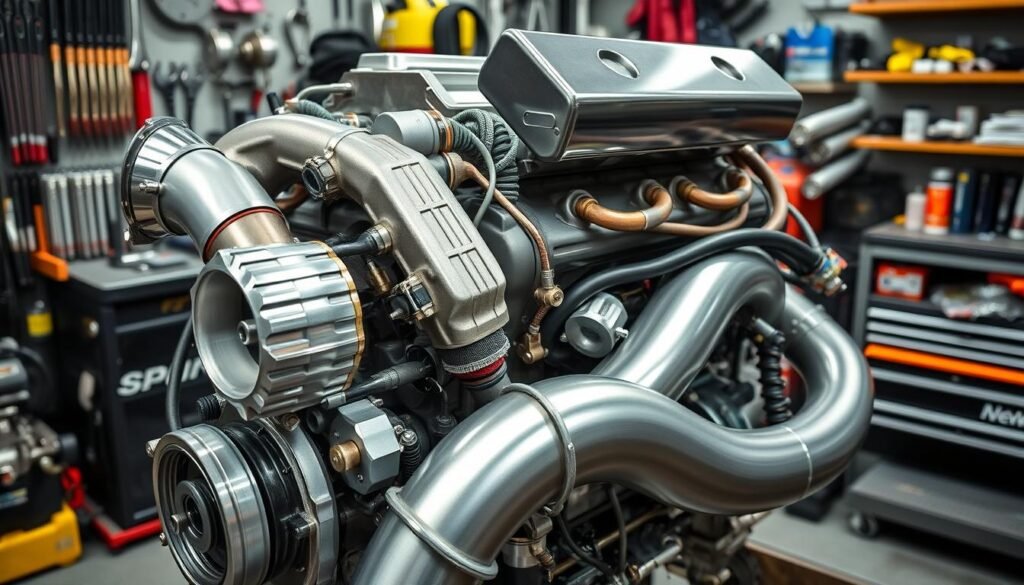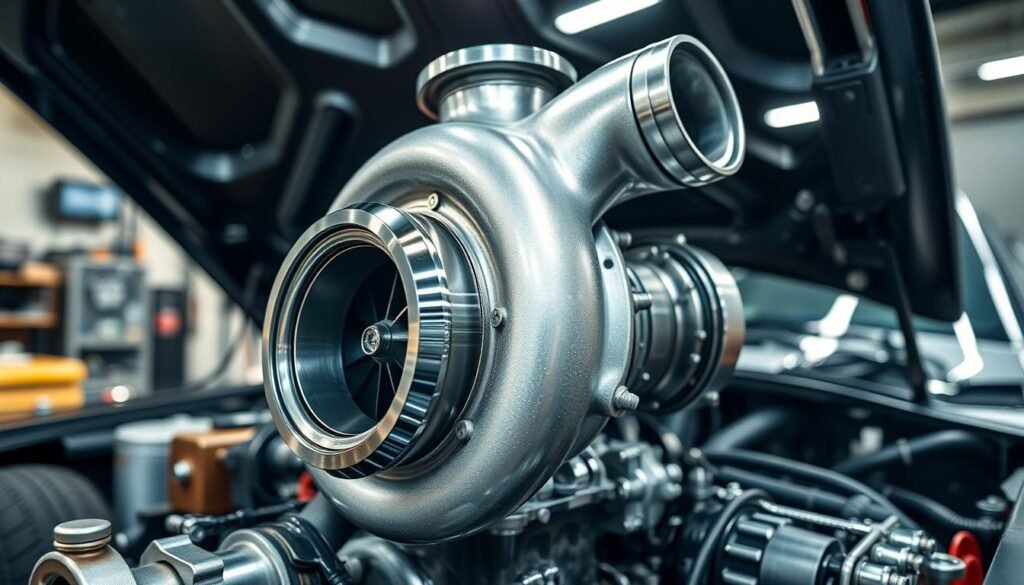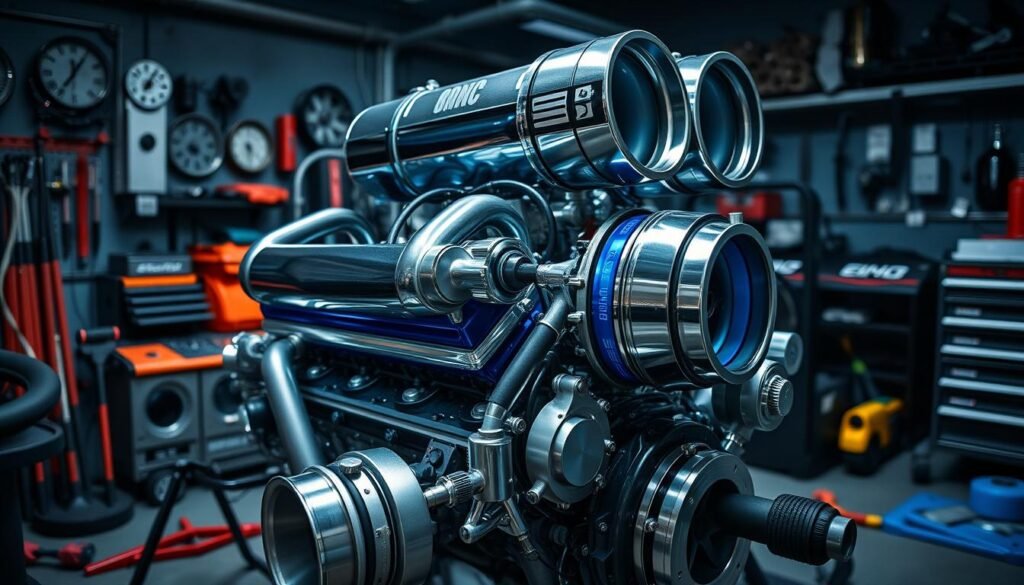The 2024 Toyota Tundra’s twin-turbo V6 engine packs a punch. It delivers 358 horsepower and 406 lb-ft of torque as standard. Higher trims offer even more power, reaching 389 horsepower and 479 lb-ft of torque.
This engineering marvel provides thrilling acceleration and towing capacity. It also maintains excellent fuel efficiency, thanks to its advanced twin-turbo design. The engine’s smooth power delivery ensures a comfortable and exciting drive.
It’s ready for any challenge, from daily commutes to tough terrain. This versatile engine tackles tasks with ease and confidence.
Table of Contents
ToggleKey Takeaways
- The 2024 Toyota Tundra’s twin-turbo V6 engine delivers a powerful and efficient performance, with up to 389 horsepower and 479 lb-ft of torque available.
- The twin-turbo setup provides excellent fuel efficiency without sacrificing performance, thanks to advanced engineering and design.
- The engine’s smooth and responsive power delivery ensures a comfortable and enjoyable driving experience.
- The twin-turbo V6 engine is known for its reliability and durability, making it well-suited for tough conditions and rigorous use.
- Turbocharging can significantly boost engine power while also improving fuel efficiency, making it a popular choice for performance-oriented drivers.
What is Turbocharging?
Turbocharging boosts engine power using exhaust gas. It spins a turbine, driving a compressor that forces more air into the engine. This allows the engine to burn more fuel and increase its power output.
Understanding the Mechanics of Forced Induction
Turbochargers force more air into engine cylinders. This increases the engine’s efficiency, allowing it to produce more power. Forced induction unlocks hidden potential in engines of all sizes.
Harnessing Exhaust Energy for Increased Power
Turbochargers use hot, high-pressure exhaust gas to spin a turbine. This turbine drives the compressor, recycling exhaust energy. This clever design gives turbochargers their impressive power-boosting abilities.
“Turbocharging is a game-changer, unlocking untapped potential in engines of all sizes.”
The Science Behind Boost Pressure
Boost pressure is measured in pounds per square inch (psi). It determines the extra power a turbocharger provides. At sea level, standard atmospheric pressure is about 14.7 psi.
A turbo providing 7 psi boost doubles the air the engine naturally aspirates. Higher boost pressure directly relates to more horsepower gains.
Measuring Power Gains in PSI
Twin turbo setups increase horsepower by 10%-13% over stock turbos. They can deliver over twice the air of single turbo setups. This is due to atmospheric pressure limits.
The DPS 62mm twin turbo runs at 78% efficiency below 2.3:1 ratio. It produces around 55-60 psi boost. At 40 psi boost, its efficiency as a single turbo drops to 70%.
A twin turbo kit at 58 psi boost produces air temps of about 375 degrees F. A stock turbo at 40 psi boost produces air temps of about 495 degrees F.
In compound turbo setups, 60 psi boost pressure results in 58-60 psi exhaust pressure. This leads to direct horsepower gains. The wastegate opens fully about 2/3 up the boost scale.
“Compound turbo systems in OEM diesel applications provide vehicle owners with response, power, and fuel economy.”
Single turbos see about a 1:1 ratio of exhaust to boost pressure. For example, 70 PSI exhaust pressure at 40 psi boost pressure.
Single big turbo Cummins may achieve nearly a 1:1 ratio. However, they suffer from significant turbo lag. This often leads customers to switch to compound turbo setups.
Intercooling: Keeping Cool for Maximum Output
Turbochargers force more air into engines, raising air temperature. This hotter air is less dense, reducing potential power gains. An intercooler cools compressed air before it reaches the engine, solving this issue.
Cooler, denser air boosts horsepower and prevents engine knock. Intercooling is crucial for maximizing power output in turbocharged engines. It helps avoid premature detonation, a common turbo engine problem.
Two main intercooler types exist: air-to-air and air-to-water. Air-to-air intercoolers are simpler, cheaper, and lighter. Air-to-water intercoolers provide denser air and fit in tight spaces.
Turbosmart, a leader in temperature management, specializes in intercooling and air cooling tech. Their boost controllers and blow-off valves are known for top performance and reliability.
| Intercooler Type | Pros | Cons |
|---|---|---|
| Air-to-Air |
|
|
| Air-to-Water |
|
|
“Turbosmart is celebrating 25 years of innovation with new products and boasts of cutting-edge Turbochargers.”
Factors Affecting Turbo Horsepower Gains
Several crucial factors influence power extraction from a turbocharged engine. The turbocharger’s size and design significantly impact power gains. Smaller turbos spool up quickly, providing immediate power surges.
Larger units may take longer to spool. However, they can deliver more power at higher engine speeds. This balance is key to optimizing performance.
Engine displacement is another important factor. Turbochargers often work better on smaller engines. They have a greater effect on the power-to-displacement ratio in these cases.
Big engines still benefit from turbochargers. However, the power increase might be more noticeable in smaller, high-revving engines.
Turbocharger Size and Design
The turbocharger’s size and design greatly influence power gains. Smaller turbos spool up faster, delivering quick power surges. Larger units take longer to spool but offer more power at high speeds.
Engine Displacement Considerations
Engine displacement affects turbocharger power gains. Smaller engines often see more dramatic effects from turbochargers. This is due to the increased air volume’s impact on power-to-displacement ratio.
Large engines can still benefit from turbochargers. However, the power increase may be more noticeable in smaller, high-revving engines.
“Twin turbo setups can add a significant amount of horsepower to an engine, ranging from 50 to 1000+ horsepower.”
Tuning for Optimal Air-Fuel Ratio
Proper tuning is key to unlocking a turbo’s full power potential. A lean engine risks damage from high temperatures. An overly rich mixture can foul spark plugs and reduce power.
The right air-fuel balance maximizes performance without compromising reliability. The stoichiometric ratio represents the ideal mixture for complete combustion. It varies depending on the fuel type.
For pure gasoline, the stoichiometric ratio is about 14.6:1. This means 14.6 parts air to 1 part fuel. Alcohol-based fuels have different ratios. A 50% ethanol blend has a ratio of 11.8:1.
Tuning the air-fuel ratio (AFR) requires precision. Lean mixtures improve fuel economy but risk engine damage. Rich mixtures provide more power but decrease efficiency.
Bosch recommends an AFR of 12.5:1 to 14:1 for maximum power. For peak fuel economy, they suggest 16.2:1 to 17.6:1.
| Fuel Type | Stoichiometric Ratio |
|---|---|
| Pure Gasoline | ~14.6:1 |
| 50% Ethanol Blend | ~11.8:1 |
| 100% Ethanol | ~8.9:1 |
| 100% Methanol | ~6.47:1 |
| 50/50 Gas/Methanol Blend | ~10.4:1 |
Careful AFR tuning optimizes turbocharged engine performance and efficiency. Understanding ideal ratios for different fuels is crucial. This knowledge helps enthusiasts maximize their boosted engines without risking reliability.
Supporting Mods for Turbo Engines
Turbocharged engines often need strategic upgrades to reach their full potential. These mods include fuel system improvements and engine strengthening. They help the engine handle extra boost safely and prevent damage.
Fuel System Upgrades
Turbochargers increase power output, which can strain the stock fuel system. Larger injectors and high-flow fuel pumps can meet the engine’s increased fuel needs. These upgrades work with engine tuning to maintain the best air-fuel ratio.
Engine Strengthening
Turbochargers create higher pressures and temperatures inside the engine. Stronger pistons, connecting rods, and head gaskets can prevent failures. These reinforcements are vital for pushing turbo setups to their limits.
Performance Parts
Upgraded intercoolers, high-flow air intakes, and free-flowing exhaust systems boost airflow and cooling. This leads to more power gains. Boost controllers, wastegates, and blow-off valves allow fine-tuning of the turbocharger’s operation.
The right supporting mods can unlock a turbocharged engine’s full potential. They address systems affected by increased boost. This ensures reliability and longevity while achieving substantial power gains.

Real-World Turbo Power Examples
Turbochargers shine in real-world performance scenarios. In some sports cars, they can add 80-100 horsepower with conservative boost. This boost significantly improves 0-60 mph times in small engines.
Small Engines with Big Gains
A 120-cubic-inch four-cylinder with 30 psi boost can match half a twin-turbo V8’s power. This shows how turbochargers extract amazing power from small engines. With proper setup, these gains deliver thrilling drives.
Twin Turbo Big Blocks
In muscle cars, twin-turbo setups can double or triple power output. A 500-horsepower V8 can potentially reach 1,000+ horsepower with twin turbos. These twin turbo big block engines showcase dramatic horsepower transformation.
These examples show how turbochargers boost power in all engine sizes. From compact sports cars to muscle cars, forced induction creates impressive turbocharger real-world examples.
Single vs Twin Turbo Setups
Forced induction choices greatly affect engine power and driving feel. Single-turbo setups offer linear power delivery, with torque available from lower RPMs. Twin-turbo configurations provide balanced horsepower and torque across the power band.
Your choice depends on desired power traits and vehicle needs. Single turbos are cheaper and easier to install. Twin turbos offer more power potential and smoother delivery, but cost more.
“Turbo LS engines, especially the 4.8, 5.3, and 6.0 truck-based engines, offer a high dollar-to-horsepower ratio that’s hard to match with other engines.”
Consider turbo size, engine displacement, and cooling efficiency for best results. These factors ensure optimal performance and reliability. Your decision should match your specific power and driving needs.
Upgrading to a Turbocharged Engine
Adding a turbocharger to your engine is thrilling, but it needs careful planning. Choosing a compatible turbo is vital for proper fitment and power delivery. The boost profile affects how quickly the turbo delivers peak power, shaping your driving experience.
Compatibility and Mounting Concerns
Compatibility is crucial when upgrading to a turbocharged engine. The turbo must match your engine’s size and layout. This includes factors like displacement, exhaust flow, and mounting points.
Poor matching can cause power delivery issues and engine damage. Proper sizing and configuration are essential for smooth operation and reliability.
Boost Profile and Driving Experience
The boost profile greatly impacts how your car feels to drive. A quick-building turbo provides exciting, responsive power at low RPMs. A gradual boost offers smoother, more linear power delivery.
Choose a boost profile that suits your car’s typical use. This ensures a satisfying and engaging driving experience.
| Upgrade Consideration | Importance | Impact on Performance |
|---|---|---|
| Turbocharger Compatibility | High | Ensures proper fitment and power delivery |
| Boost Profile | High | Determines driving feel and responsiveness |
| Supporting Modifications | High | Enables the engine to handle increased power safely |
A strategic approach is key when upgrading to a turbocharged engine. Balance compatibility, boost profile, and supporting mods carefully. This unlocks your engine’s full potential and creates an exhilarating driving experience.

Turbo Drawbacks and Considerations
Turbochargers boost power but have drawbacks. One issue is reduced throttle response, especially with larger turbos. This can cause turbo lag, delaying peak power delivery.
Throttle Response and Turbo Lag
Single turbo setups are slower to spool but take up less space. They don’t have parasitic drag like superchargers. Single turbo kits excel at making big horsepower with a broad power band.
Twin turbos spool faster than single turbos. Each turbo only needs exhaust from four cylinders to spool up.
Heat Management Strategies
Turbocharging increases exhaust gas temperatures (EGTs), risking engine components. Heat management strategies like water injection, EGR coolers, and intercoolers maintain engine health.
Two smaller turbochargers in a twin-turbo setup are more efficient than one big turbo. However, single turbo kits are more cost-effective to install.
| Turbo Drawbacks | Considerations |
|---|---|
| Throttle response and turbo lag | Single turbo produces maximum boost at higher RPM, allowing for increased power up to 1500 HP and more |
| Increased exhaust gas temperatures | Choosing the right turbo for a car starts with a horsepower target, ensuring the turbo is within the suitable range for the engine displacement |
“Single turbo kits are more cost-efficient to install compared to twin-turbo setups.”
Turbocharging offers significant power gains but has potential drawbacks. Effective heat management is crucial for long-term engine reliability and performance.
twin turbo: The Path to Performance Nirvana
Turbocharging can unlock your vehicle’s true performance potential. It can turn a good car into a great one. A twin-turbo setup offers a range of possibilities, from family cars to high-octane thrills.
A well-tuned twin-turbo system provides reliable and exciting performance. It can make your daily commute extraordinary. At sea level, standard air pressure is 14.7 psi. A turbo boosting 7 psi can double the air intake.
In smaller engines, turbochargers can add 80-100 horsepower. Twin-turbo setups in muscle cars can double or triple power output. Proper tuning is crucial to prevent engine damage.
Single-turbo setups offer linear power delivery. Twin-turbo configurations provide balanced horsepower and torque. Upgrading an engine with an incompatible turbocharger can cause issues.
The turbocharger’s boost profile affects its power delivery across the RPM range. Turbocharging can increase fuel efficiency by allowing engines to operate at full capacity only when extra power is needed.
Conclusion
Turbocharging offers more than just excitement. It can boost fuel efficiency by using engines at full capacity only when needed. This technology allows for smaller engines without sacrificing performance, an attractive option in our efficiency-focused world.
A well-tuned turbocharger can define your car’s character. It transforms the driving experience, delivering unmatched power and reliability. Understanding turbocharging’s impact on horsepower helps unleash your engine’s full potential.
Twin turbo engines balance power delivery effectively. They optimize performance at different engine speeds, ensuring a consistent power curve. The right turbocharging setup can significantly improve your vehicle’s performance or fuel efficiency.
Resources like Turborevs can help you find the best turbocharging accessories. These components can maximize your engine’s potential. Embracing forced induction unlocks new levels of driving excitement and vehicle performance.
FAQ
What is the power output of the twin-turbo V6 engine in the 2024 Toyota Tundra?
The 2024 Toyota Tundra’s twin-turbo V6 engine packs a punch. It delivers 358 horsepower and 406 lb-ft of torque as standard. Higher trims boost output to 389 horsepower and 479 lb-ft of torque.
How does a turbocharger work to increase engine power?
A turbocharger uses exhaust gas to compress air before it enters the engine. This allows the engine to burn more fuel each second, boosting power output. The turbo spins a turbine, driving a compressor that forces air into the engine’s intake.
What is boost pressure and how does it affect power gains?
Boost pressure, measured in psi, determines the extra power a turbocharger provides. Higher boost leads to more power. A 7 psi boost doubles the air the engine naturally takes in. Managing boost pressure is crucial to prevent engine damage.
How does an intercooler help maximize the power output of a turbocharged engine?
Turbocharging increases air temperature, which can reduce power gains. An intercooler cools the compressed air before it reaches the engine. This results in more horsepower and prevents engine knock. Proper intercooling is key for maximizing turbocharged engine power.
What factors affect the power gains from a turbocharger?
Turbocharger size and design impact power gains significantly. Smaller turbos spool up quicker, while larger ones provide more power at higher speeds. Engine displacement also plays a role. Turbochargers can be more effective on smaller engines.
Why is proper tuning essential for a turbocharged engine?
Proper tuning ensures the full power potential of a turbo. It balances air and fuel mixture to maximize performance. Running lean risks engine damage, while running rich can diminish power. Striking the right balance is crucial for reliability.
What supporting modifications might be needed for a turbocharged engine?
Supporting mods ensure the engine can handle additional power safely. These may include fuel system upgrades like larger injectors. Strengthening components such as pistons, rods, and head gaskets might also be necessary.
Can turbocharging dramatically increase power output in real-world applications?
Turbocharging can provide significant real-world power gains. In small sports cars, it can add 80-100 horsepower with conservative boost. For muscle cars, twin-turbo setups can double or triple the original power output.
What are the differences between single and twin-turbo setups?
Single-turbo setups often offer more linear power delivery. Twin-turbo configurations provide a balanced spread of horsepower and torque. The choice depends on desired power characteristics and specific driving needs.
What considerations are important when upgrading an engine to a turbocharger?
Compatibility and mounting are crucial when upgrading to a turbocharger. The turbo must fit the engine’s size and orientation. The boost profile should align with the car’s typical usage for a satisfying driving experience.
What are some of the drawbacks or considerations with turbocharging an engine?
Turbocharging can lead to turbo lag, especially with larger turbos. Increased exhaust gas temperatures pose risks to engine components. Heat management strategies like water injection and intercoolers are necessary for engine health and reliability.

